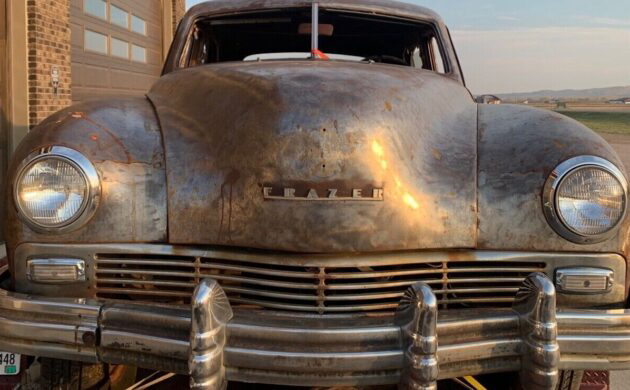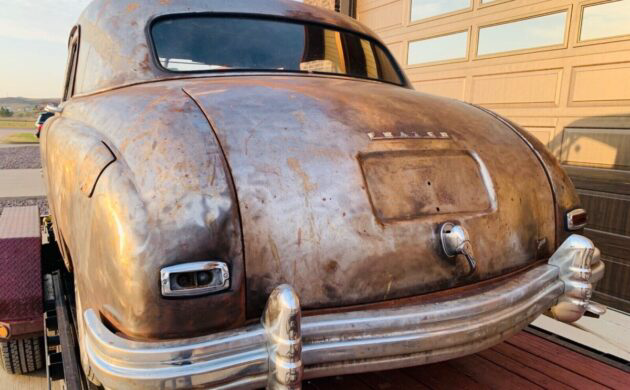First, let’s end the confusion with this listing, which proclaims this car to be a 1948 Kaiser Manhattan Darri. Well, not exactly, it’s a 1948 Frazer Manhattan that was produced by the Kaiser-Frazer Corporation. Darri probably has something to do with Darrin, as in Howard Darrin, the automotive designer behind the 1954 Kaiser Darrin two-seater. No surprise, this one’s probably a flip and cars in that category are often wrongly described. Regardless, this Fort Pierre, South Dakota domiciled sedan is one to review. It’s available, here on eBay for a current bid of $1,000. Larry D gets credit for this find.
First offered in 1947, the Frazer Manhattan was assembled in four-door sedan and convertible body styles, before being discontinued in 1951 along with all other Frazer-branded cars. The Howard Darrin connection was early on, starting in 1946, and his influence was evident with the initial sedan models. After ceasing the Kaiser-Frazer association for a few years, Darrin returned and got involved with the previously mentioned Kaiser-Darrin sports car. Frazer managed a seventeenth-place finish in the ’48 production race with an output of 48K units, 18K being Manhattans, while the Kaiser side of the house managed 91K copies and a fourteenth-place finish.
The seller mentions, “Body is sanded to bare metal” probably as the result of an earlier attempted restoration. The body does show integrity though we’re told the floors need to be replaced and the passenger side fender and door will require straightening. The seller claims that this Manhattan has not been exposed to the elements but that’s probably a reference to his time of ownership; the rotted floors obviously state otherwise.
Power should be provided by a 100 HP, 226 CI, in-line, six-cylinder engine but it, and its three-speed manual transmission, have been removed and are not photographed though the engine is claimed to not be seized. An image of it, along with a word or two about completeness or serviceability, is certainly warranted and it’s a bit suspicious that it’s not offered.
The interior is essentially gutted. There is a fogged instrument panel and a cracked steering wheel but not much else. The what-was-painted-at-one-time steel dash is all surface rust and the deleterious condition of the floor pans is obvious. Things such as the seat frames and door panels are nowhere in sight.
The draw to a car like this Frazer, as opposed to an old car like this 1953 Buick Special, is the fact that Frazer was short-lived and is now a fallen flag manufacturer. Frazer, and its Kaiser sibling, were developed at a time when all things automotive seemed destined for a boundless future. Sure, the Buick is in better shape, but Buick is still around and there are probably an uncountable number of old Specials, Supers, Roadmasters, Electras, Wildcats, and Rivieras still occupying the barns, garages, driveways, and fields of America. We all favor old cars, that’s the gist of Barn Finds, but some are beyond redemption and I fear that may be the case with this 1948 Frazer Manhattan. What says you?








Enthusiasm for this car hasn’t hit me yet. I’d bet the the rust shown on the floor and heater is just part of what’s probably going on underneath. After restoration what’s it worth?
I don’t see this as anything but an oddity, either. Frazer, the car, was a half-thought-out brand/division of Kaiser-Frazer Corporation…the idea was that the Kaiser brand would carry Henry Kaiser’s revolutionary ideas – FWD, aluminum body, a few others. The Frazer was the baby of partner Joseph W. Frazer’s objection – he wanted to enter the market with a totally conventional car, and this one was it.
The FWD Kaiser turned out to have too many engineering roadblocks – and Kaiser, richer than 98 percent of America, turned out to be a single-chip holder in the high-stakes poker game that was American auto manufacture at the time. Kaiser-Frazer was always undercapitalized – and it was Henry Kaiser’s slow realization that led him to retreat, take over Willys-Overland, which was in financial dire straits, and retreat to a world of specialty trucks (4wd was not mainstream, not then) and government contracts.
Interestingly, Kaiser set up IKA in Argentina – which was where the tooling, and the Continental-Kaiser Tornado OHC 6 wound up, and IKA was very successful for another twenty years, until Henry’s death led to the dismemberment of Kaiser Industries and sale for estate taxes.
And, Joseph Frazer? He was actually as substantial a man in the industry as was Kaiser in Kaiser’s previous lines of business. Frazer was a former head of Willys-Overland, who bought control of Graham-Paige, out of bankruptcy court, during WWII. His plan was to recapitalize and revive the G-P line of cars. But Kaiser’s entry also intrigued him, and he thought an industrial wizard (Liberty Ships) with a proven history of success, would aid his project.
G-P was originally a separate business, making Kaiser and Frazer cars under contract, until Kaiser-Frazer bought out G-P. Following that, with the lesser success of the K-F line – no money for cosmetic yearly changes, no source for a V-8 engine – Frazer insisted on a scaling back, to find a lower breakeven number. Kaiser, instead, insisted “Kaisers never retreat!” and built cars without order – calling to mind the later problems Chrysler had with its Sales Bank. Henry Kaiser understood government contracts, but not the consumer market. He wanted to warehouse unsold cars like tomato soup cans. That obviously didn’t work out, especially after Kaiser was forced by demand to institute some cosmetic yearly changes. Many unsold Kaisers were re-serialed and remade on dealer lots into next-year’s models.
Frazer resigned, knowing the company was headed for a reckoning. Henry pulled off a salvaging of the business, but it was a serious setback and money loser.
Footnote: Kaiser never lost his desire to break into the mainstream auto industry. The then-revolutionary Jeep Wagoneer was probably a step in that direction. So was Kaiser Industries’ quiet purchasing of American Motors stock. No historian claims it, but my reading suggests: Kaiser was planning a run on AMC, and he’d finally have his functioning car company.
Instead, Kaiser died in 1967, and with inadequate estate planning. That led to a four-year fire sale of the Kaiser Industries assets – including the former Willys Motors, renamed Kaiser-Jeep. Kaiser Industries, a large AMC stockholder, apparently floated the idea of AMC buying K-J. AMC management was divided; it was not the time for a big capital expenditure. But the idea won out, and Jeep was purchased – a heavy cost but a fortuitous move. Didn’t hurt that a big shareholder, the Kaiser Estate, was ready to vote FOR.
The American Motors stock, along with Kaiser Steel, Kaiser Chemical, Kaiser Broadcasting…were all quietly sold to other holders or spun off. All that is left is Kaiser Permanente, which was given non-profit status.
And the Frazer marque is now all but unknown. And frankly, it’s irrelevant, IMHO.
Thanks for the background info!
Kaiser built the first hatchback. According to legend, he couldn’t afford to build a station wagon. So he drew on the back of a napkin an idea for a four door sedan that had a back hatch and a tailgate. He called it the “Traveler”. Marketed it as an ambulance or camping vehicle. Looked like a sedan, but the whole back end opened up. With the back seat folded down there’s room for me to lay down, I’m 6’5: He didn’t have the funds to do much redesigning, so he had the left rear door welded shut (still had door handle, but didn’t open) and stored the spare tire inside the door so he could have a flat floor in the back. I’ve got one that I got about 15 yrs ago to restore, lots of surface rust, but still untouched. I may get around to it, or it may show up on Barn Finds in a few years.
Friends don’t let friends buy from flippers.
I see they had the dentless paint removal performed. Now they have a rust farm.
So sad that Kaiser didn’t trash introducing the Henry J, and continue developing a V-8, as well as introducing a 2 door hardtop. Styling was way ahead of the others, beginning with the 1951 body, and doing a beautiful upgrade in 1954. I’ve owned 3 ’54s and hope to have a 4th one soon….but, will have a GM frame in order to use GM parts, GM tranny, AC, power steering, tilt steering wheel, power windows, radial tires, but still white walls. Just bringing it up to date. Number 3 was on the side of the Peterson Automotive Museum in Los Angeles before I bought it. Had been painted red with a white top (sharp looking), and only hand-sized holes in the 2 front floor boards. Had to sell to pay cancer surgery bills…ugh. Donations accepted for next purchase…lol. If I had the money I’d start production of them…seriously. Sure would look better than what has been available…for years…and carry 6 people instead of 4.
Kaiser-Frazer was in fact working on a V8. Engineer David Potter was running a crash program to get one into production by about 1956. Unfortunately for Kaiser, his own timeline and budget ran out.
Potter stuffed his design work under his coat and left for the V8-less American Motors – where somehow they got a V8 up and running in less than a year.
A later version of that first AMC V8, the 327, became the V8 option in Kaiser Jeep’s Wagoneer, in its third production year. A sort of coming back home for the design.
Check out the ’49 Frazer – Will it Run? playlist on Cold War Motors YouTube channel (and subscribe!)
Take the$1k offer and run don’t walk to the bank. After looking at these photos I’d run, not walk away from this one
thinkin the 1 yr earlier tucker torpedo – I came to see the center grill head light. o0OP, this is the co that made a fav (along w/Hudson) – traveler & nomad (sedans w/trunk/window above having hinge @ roof top, hatch-like) the sleep-in cars.
I like this, before the bulgemobiles of the ’50s (tri-5 is example) it has that MB ponton look. Not far from the more streamlined (ford) shoe box. Now running bds have disappeared, windshields begin to rake’n other more mid/late century innovations. Ouur loss, nother orphan~